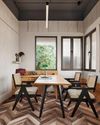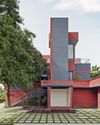Mathias Lehner interviewed architect William Jan Landman about his take on the future of sustainable architecture –

How will the future of architecture look like? Will architecture, for example, improve the health of its inhabitants? Amsterdam based studio Paul de Ruiter Architects has a pragmatic yet ultimately bold approach towards these questions of sustainability: “The best way to predict the future is to create it yourself.”
In the summer of 2017, the stunning Hotel in the Amstel Quarter designed by Paul de Ruiter Architects and Mulderblauw opened in Amsterdam. Paul de Ruiter Architects & Arup also designed the sustainability concept of the hotel. The 18.500m² hotel will illustrate the highest possible standards when it comes to sustainability. Its LEED Platinum-certified design boasts an intelligent façade and a green house on the roof, where vegetables used in the hotel kitchen are grown, next to collecting warmth for the building’s heating. Furthermore, the hotel produces electricity by recycling frying oil. The chefs even raise their own fish in a closed aquaponics system. Lettuce is grown on top of the fish basin – both the fish and the lettuce will be used in the kitchen. Eventually, the hotel delivers just 1 percent of the average greywater amount into the sewers.
Willem Jan Landman of Paul de Ruiter Architects said, “But most of all, it is a very healthy building. The guests are not bothered by all the intelligence of the design, but they are experiencing a relaxed and a very aesthetic stay. Compare the hotel to a car: Why would you want to drive in a 20th century Diesel automobile when you can have a Tesla?” The Hotel in the Amstel Quarter is quite a distinction when it comes to sustainable hospitality. “In a very Dutch way, we wanted to go as far as possible in innovation.”
This story is from the {{IssueName}} edition of {{MagazineName}}.
Start your 7-day Magzter GOLD free trial to access thousands of curated premium stories, and 9,000+ magazines and newspapers.
Already a subscriber ? Sign In
This story is from the {{IssueName}} edition of {{MagazineName}}.
Start your 7-day Magzter GOLD free trial to access thousands of curated premium stories, and 9,000+ magazines and newspapers.
Already a subscriber? Sign In

A GRECIAN RETREAT
Shimona Bhansali imbues a subtle touch of opulence to this home in Mumbai

A BOLD STATEMENT
Dhampur Sugar Mills Limited's workspace in New Delhi designed and built by Officebanao adopts an industrial narrative

A BREATH OF FRAGRANT DESIGN IN DELHI'S HEART
An office that smells like perfumery; that is the vision that TWI brought to life in this office space designed for an acclaimed perfume company in India

MASTER OF ALL TRADES
The ethos of forward-thinking and ingenuity finds its architectural counterpart within the walls of Nikhil Kamath and Abhijeet Pai's office-a vision of organic design infused with the essence of India

A TOUCH OF OPULENCE
Designed by Aparna Kaushik, this Delhi office displays an interesting balance of classic aesthetics and contemporary sensibilities

THE WOODEN WONDERLAND
Priyanka and Piyush Mehra envision a stunning experience centre for Vikas Plywood

THE HUB: BUILDING COMMUNITIES
Studio Lotus designs a dynamic mixed-use community hub that activates Chennai's largest IT Park

THE WINNER'S PERCH
Baldiwala Edge designs a Singapore-based ship broker's office as a torch collector's paradise, offering a 360-degree bird's-eye view of the Mumbai skyline

THE DIRECTOR'S CABIN
Designed by Envisage, this office gives a new definition to the traditional notion of biophilia

Designing Corporate India
From weaving the magic of a Star Trek-themed command centre to crafting bespoke block-printed workstations, Vijaya Bhargav and Arnab Ghosh-the trailblazing co-founders of Ostraca-have astonishingly transformed a staggering 29 million square feet of office space for India's tech giants and global enterprises-all while maintaining a flat hierarchical company culture-fuelling a master class in corporate design